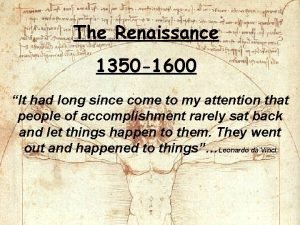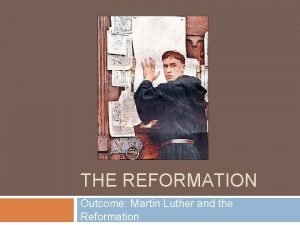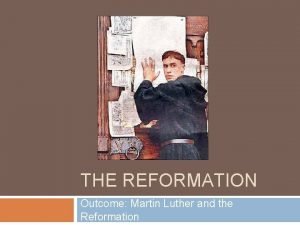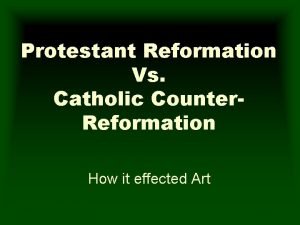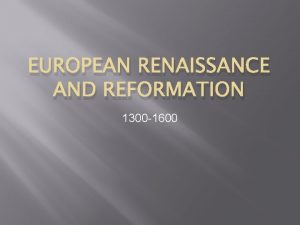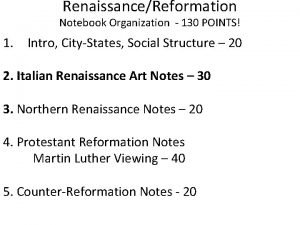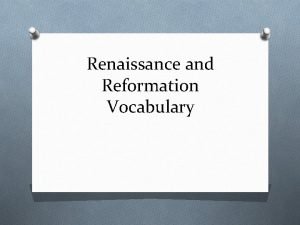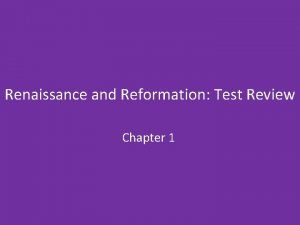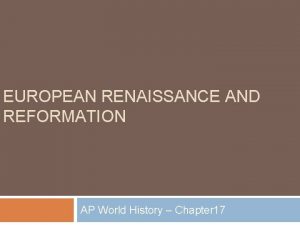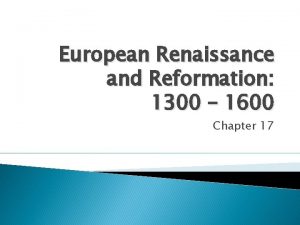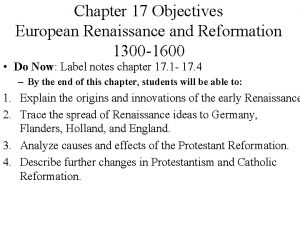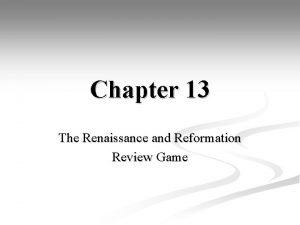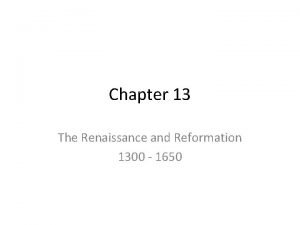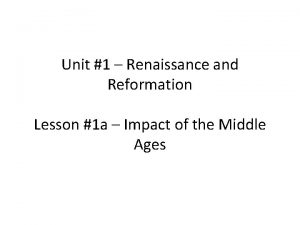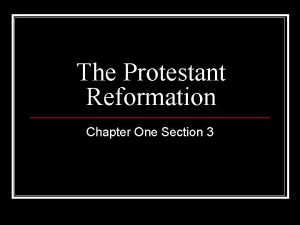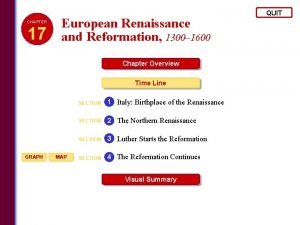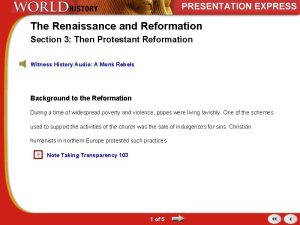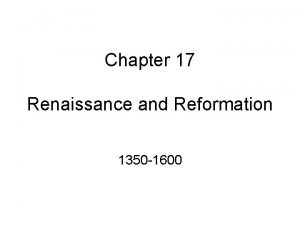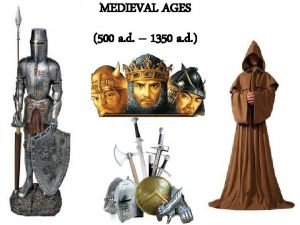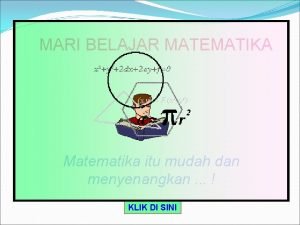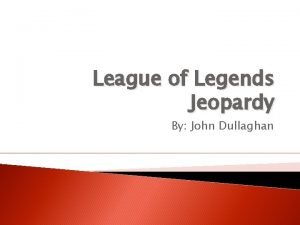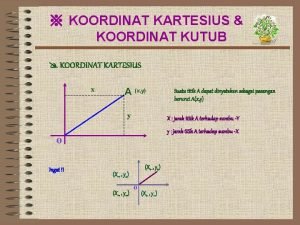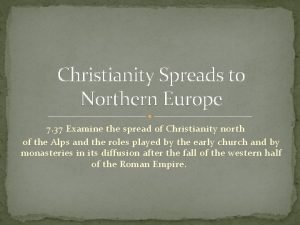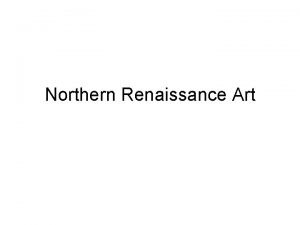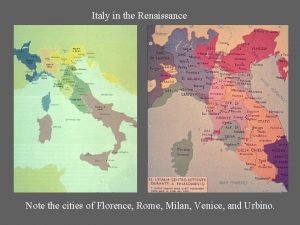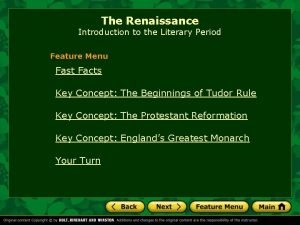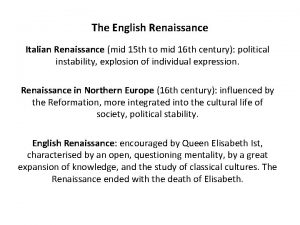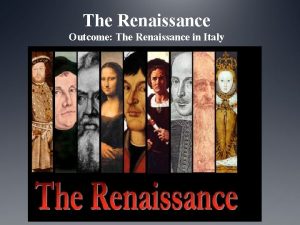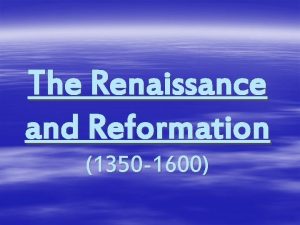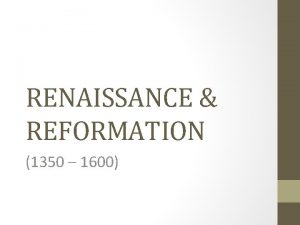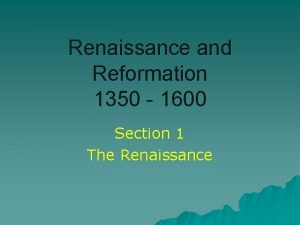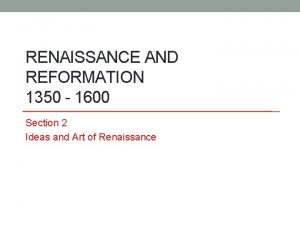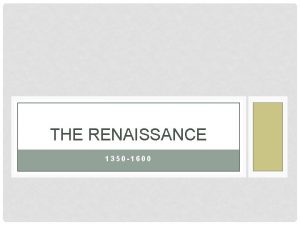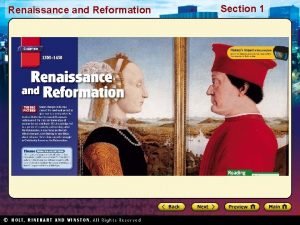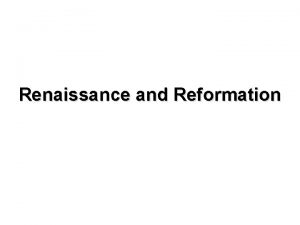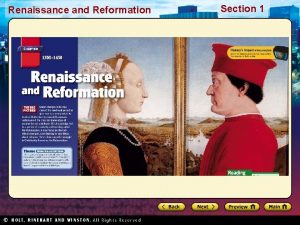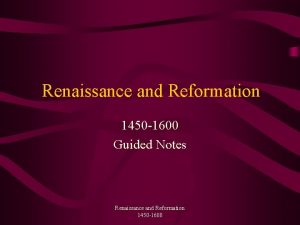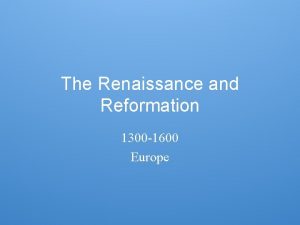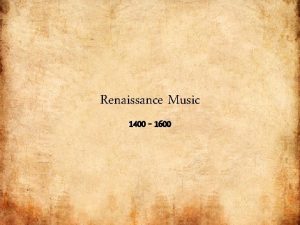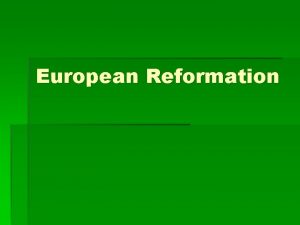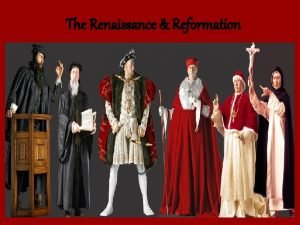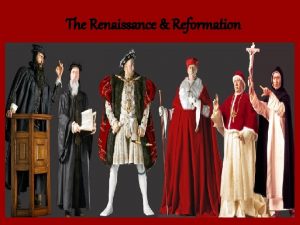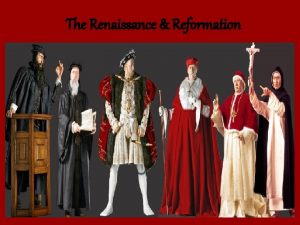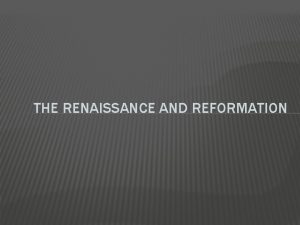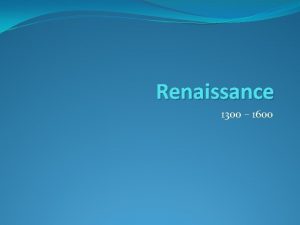Chapters 9 10 Renaissance and Reformation 1350 1600




































- Slides: 36

Chapters 9 & 10 Renaissance and Reformation (1350 -1600)

Section 1: The Renaissance • Renaissance=“rebirth”. • B/w 1350 & 1550, a # of people in Italy believed that they were experiencing a rebirth of ancient Greek and Roman worlds. • Italian Renaissance- period of European history that began in Italy and spread to the rest of Europe.

Characteristics of Renaissance 1. Renaissance Italy was a largely urban society; small city-states dominated Italian political, economic, and social life. – Italians developed a secular, or worldly, view as opposed to a strictly religious view of life.

Characteristics of the Renaissance 2. An age of recovery from the plague, political instability, and a decline of Church power. • Italian thinkers became aware of their own Roman past • Interest in culture and politics 3. Renaissance Italians began to emphasize individual ability. • For example, Leonardo da Vinci was a painter, sculptor, architect, inventor, and mathematician.

Italy’s 5 major city states • 2 city states – each led by a single ruler - Rome and Naples • 3 city-states remained independent: Milan Venice, and Florence (not united under single leader). – These city-states profited from trade during the Crusades.

• • • Milan one of the richest city-states. (north) – Visconti family were the dukes of Milan – conquered by Francesco Sforza, with a band of mercenaries. – Sforza generated enormous revenues by creating an efficient tax system. Venice a link between Asia and western Europe – Was officially a republic. – Wealthy merchant/aristocrats ran the government. – The trade empire was very profitable and made Venice an international power. Florence came under the control of the Cosimo de’ Medici family. – Cultural City of Italy – The Medici ran the gov’t behind the scenes.

2 city states under single ruler • Naples: Located in southern Italy, Naples was the only major state in Italy ruled by a hereditary monarchy • Rome: Rome was the capital of the territories known as the Papal States and was under the control of the Church.

Machiavelli on Power • Niccolò di Bernardo dei Machiavelli (3 May 1469 – 21 June 1527) – Wrote The Prince a book that influenced political leaders. – He wrote the book to gain the affection of the Medici.

Machiavelli on Power • In his book The Prince, Niccolo Machiavelli rejected the notion that a prince (ruler) must rule according to morals. • Instead, he insisted that a prince should do whatever was necessary to acquire and keep power. • A prince acts on behalf of the state; willing to let his conscience sleep. http: //www. brainyquote. com/quotes/authors/n/niccolo_m achiavelli. html

Society • At the top of Renaissance society were the nobles who held important political posts. (made up a 2 -3% of population) • Peasants made up 85% to 90% of the total European population; serfdom declined during the Renaissance. • A third group, townspeople, included – rich patricians -wealthy from trade and banking, – burghers shopkeepers, guild members, unskilled workers, and the unemployed.

Society • The father-husband was the center of the Italian family. • Marriages were arranged to increase family fortunes. • A dowry was given by the bride’s family to the husband.

Section 2: Ideas and Art of the Renaissance • A key intellectual movement of the Renaissance was humanism. • Humanism was based on the study of the works of ancient Greece and Rome. • Humanists studied grammar, rhetoric, poetry, moral philosophy, and history.

Vernacular Literature • Petrarch, the father of Italian Renaissance humanism, began the search forgotten Latin manuscripts. • While many humanists wrote in Latin, some Renaissance authors wrote in the vernacular (the language of their regions).

Vernacular Literature • Example, Dante wrote in Italian & Chaucer wrote in English. – Dante Divine Comedy - Poem: Soul’s Journey to Salvation – Chaucer The Canterbury Tales. • - Stories told by 29 pilgrims journeying to the tomb of Saint Thomas a Becket at Canterbury, England – Christine de Pizan The Book of the City Ladies - Denounced many males writers who had argued that women are unable to learn. She argued that they could learn if they could attend the same schools.

Renaissance Education • Renaissance humanists emphasized education as a means of attaining virtue and wisdom. • Liberal Studies: history, moral philosophy, eloquence (or rhetoric), letters, poetry, mathematics, astronomy, and music. • Men had better opportunities than females

Art: Painting • Artists became masters of perspective (depth in paintings) and developed a new, more realistic style. • Artists used their knowledge of geometry to master perspective and their knowledge of anatomy to paint more realistic human forms. • Fresco- painting done on fresh, wet plaster with water-based paints.

Sculpture and Architecture • Sculptors also attempted to create more realistic human figures. • Renaissance architects sought to create spaces that were human-centered instead of overwhelming like Gothic cathedrals often were.

Filippo Brunelleschi-San Lorenzo (Florence) -Classical design create an env. that is not overwhelmed as Gothic.

Section 2 (continued) • The High Renaissance (between 1490 and 1520) is associated with Leonardo da Vinci, Raphael, and Michelangelo.

Raphael- “School of Athens”- world of balance, harmony and order- principles of classical Greek and Roman Art.

Ch. 10 -1 The Protestant Reformation • During the 2 nd half of the 15 th century, Christian humanists Desiderious Eramus paved the way for Martin Luther’s reform movement. Political instability in the Holy Roman Empire allowed Lutheranism, the first Protestant faith to spread. The Peace of Augusburg formally accepted the division of Christianity in Germany-Lutheranism and Catholicism

The Protestant Reformation • The Protestant Reformation - reform movement that divided the western Church into Catholic and Protestant groups. • Martin Luther begin the Reformation in the early 1500 s

Prelude to Reformation • During the 2 nd half of the 15 th century, Christian humanism the new classical learning renaissance spread to northern Europe. MAJOR GOAL= Reform the Catholic Church • Believed in the ability of human beings to reason and improve themselves. – read the classics, become more religious

Prelude to Reformation • Desiderious Erasmus- Christian humanist • “the philosophy of Christ” = Christianity should show people how to live good lives on a daily basis, not just provide beliefs for them to be saved

Need for Reform • Why the call for reform? - Corruption: From 1450 -1520, a series of Renaissance popes, focused more on politics & worldly interests than on spiritual matters. - church officials used their power to advance their careers and their wealth; ignorant of spiritual duties.

Need for Reform • Ordinary people desired meaningful religious expression and assurance of their salvation or acceptance into Heaven. • To achieve salvation, many Christians used relics to gain an indulgence (a release from all / part of the punishment for sin). • This could reduce time in purgatory by 1, 443 years. The Church also sold indulgences.

Martin Luther • Monk & professor at the University of Wittenberg, in Germany. • Traditional Catholic teaching = faith and good works required for salvation. • Luther=only faith was necessary (justification by faith alone). • Bible =only source of religious truth.

Martin Luther • Luther strongly objected to the selling of indulgences. • On October 31, 1517, Luther sent a list of Ninety-five Theses to his church superiors; they were an attack on abuses in the sale of indulgences.

Lesson 1(continued) • Thousands of copies of the Ninety-five Theses were printed and spread to all parts of Germany. • At first, Luther was not taken seriously by the pope. • By 1520, Luther had begun to move toward a break with the Catholic Church. • Luther kept only two sacraments-baptism & the Eucharist; he called for clergy to be allowed to marry.

Lesson 1(continued) • The Church excommunicated Luther in January 1521. • Luther was called before the Holy Roman Emperor (Charles V), but he refused to change his views. • By the Edict of Worms, Luther was made an outlaw within the empire. • His works were to be burned and Luther captured and delivered him to the emperor. • However, Luther was protected by his local German ruler, Frederick.

The Rise of Lutheranism • Many other German rulers began to support Luther / Lutheran churches were established. • Lutheranism was the first Protestant faith. • Busy with other challenges, Charles V was unable to put down the Protestant movement. • With the Peace of Augsburg in 1555, the division of Christianity in Germany was formally recognized

Lesson 2: The Spread of Protestantism (Switzerland) • A Church reform movement, led by Ulrich Zwingli, began in Switzerland. • The movement favored plain churches and scripture readings. • In 1531, Zwingli was killed in a war b/w Protestants and Catholics. • John Calvin replaced Zwingli as the leader of Swiss Protestantism.

Switzerland(continued) • For the most part, Calvin agreed with Luther. • Calvin also believed in predestination, the idea that God had determined in advance who would be saved and who would be damned.

Protestantism in England • In England, Protestantism originated with King Henry VIII. • Henry broke with the Catholic Church so that he could divorce his wife Catherine of Aragon and marry Anne Boleyn since he needed a male son. • The marriage was “Null and absolutely void” The Act of Supremacy of 1534 declared that the king was the head of the new Church of England (Anglican Church). • While Henry sold off some church land, his doctrines remained essentially Catholic.

Protestantism in England(continued) • Henry’s son by his third wife was Edward VI came to power at age 9 and would die before age 16. • During Edward’s rule, church officials adopted more Protestant forms of worship. • Mary (Henry’s daughter by Catherine) came to the throne in 1553 and tried to reinstate Catholic worship. • She had many Protestants burned as heretics thus earning the nickname Bloody Mary. • Elizabeth (Henry’s last child) kept England Protestant. • The Catholic Reformation occurred in 16 th century.

The Catholic Reformation • The Catholic Reformation occurred in 16 th century. • The Society of Jesus, or Jesuits, was formed by Ignatius of Loyola (a Spanish nobleman). • The Jesuits used education to spread their message and restored Catholicism to some parts of Germany. • The Council of Trent, beginning in 1545 & meeting off and on for 18 years worked on reforming the Church. • The selling of indulgences was forbidden, but other Church doctrines (such as the seven sacraments) were kept in place.
 Thermometer inventor
Thermometer inventor Renaissance 1350
Renaissance 1350 The reformation outcome: martin luther and the reformation
The reformation outcome: martin luther and the reformation The reformation outcome martin luther and the reformation
The reformation outcome martin luther and the reformation Protestant reformation vs catholic reformation
Protestant reformation vs catholic reformation The time of rebirth
The time of rebirth Historical events in the renaissance
Historical events in the renaissance European renaissance and reformation
European renaissance and reformation Topic 4 the renaissance and reformation
Topic 4 the renaissance and reformation Renaissance and reformation interactive notebook
Renaissance and reformation interactive notebook Renaissance and reformation vocabulary
Renaissance and reformation vocabulary Chapter 1 renaissance and reformation
Chapter 1 renaissance and reformation European renaissance and reformation answer key
European renaissance and reformation answer key European renaissance and reformation chapter 17
European renaissance and reformation chapter 17 European renaissance and reformation chapter 17
European renaissance and reformation chapter 17 Chapter 13 the renaissance and reformation
Chapter 13 the renaissance and reformation Chapter 13 renaissance and reformation
Chapter 13 renaissance and reformation Unit 4 lesson 1 the renaissance
Unit 4 lesson 1 the renaissance Give up one’s views or beliefs
Give up one’s views or beliefs Chapter 1 european renaissance and reformation
Chapter 1 european renaissance and reformation Chapter 12 renaissance and reformation
Chapter 12 renaissance and reformation The renaissance and reformation section 3 quiz
The renaissance and reformation section 3 quiz Chapter 17 renaissance and reformation
Chapter 17 renaissance and reformation Medieval times commercial
Medieval times commercial Kaki sudut adalah
Kaki sudut adalah Jeopardy legends
Jeopardy legends 1350 ce
1350 ce Besar setiap sudut segi 8 beraturan adalah
Besar setiap sudut segi 8 beraturan adalah Contoh soal vektor, koordinat kartesius
Contoh soal vektor, koordinat kartesius Outcome of renaissance
Outcome of renaissance Italian renaissance vs northern renaissance venn diagram
Italian renaissance vs northern renaissance venn diagram The renaissance outcome renaissance painters/sculptors
The renaissance outcome renaissance painters/sculptors Northern renaissance vs italian renaissance
Northern renaissance vs italian renaissance Renaissance vs high renaissance
Renaissance vs high renaissance The renaissance introduction to the renaissance answer key
The renaissance introduction to the renaissance answer key Italian renaissance vs english renaissance
Italian renaissance vs english renaissance The renaissance outcome the renaissance in italy
The renaissance outcome the renaissance in italy
